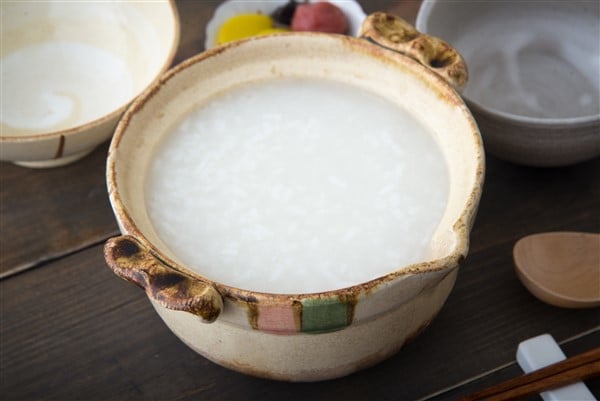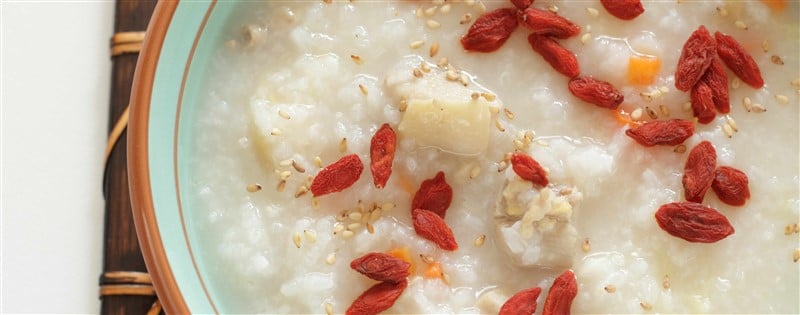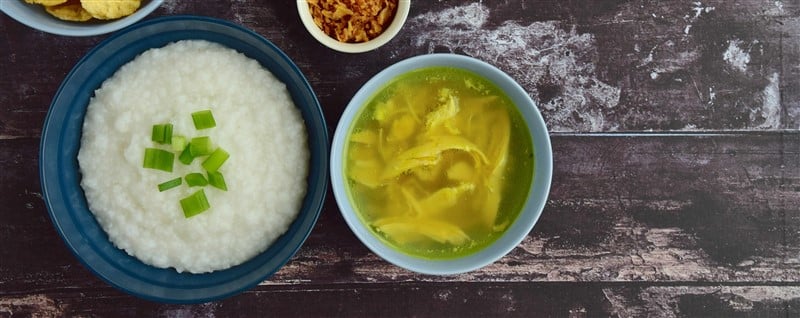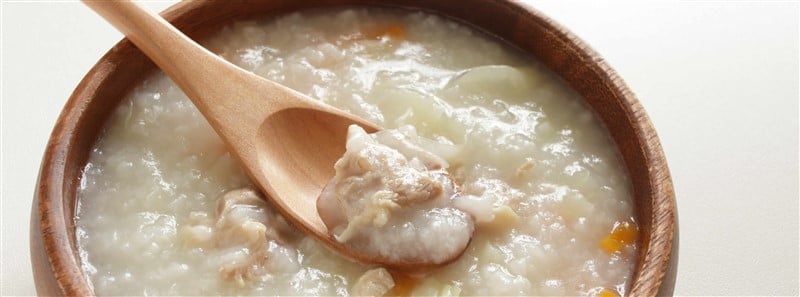How to Make Congee (From Basic to Advanced)
By Charlotte Schell | 14 min. read

Besides dim sum, congee has been the poster child for Cantonese cuisine. It’s been written about as a silky, comforting food from China that is packed with flavors and treasured ingredients. If you are reading this, you’ve probably experienced the lingering tastes, the soothing fragrance, and the creamy texture of Cantonese congee.
Since ancient times, congee has been beloved by Chinese people. It’s not one specific dish, but a plethora of hundreds of combinations of ingredients complemented by different unique cooking methods. Based on the mere variety of recipes and cooking techniques, congee can probably stand alone as its own culinary branch among other regional cuisines. It’s a dish Chinese can eat endlessly without getting tired of. Mild, but revelatory, congee is full of flavors that slowly mesmerize you into an indescribable experience that you won’t be able to forget.
How to Make Hong Kong Style Congee
For those of you who grew up with mom or grandmother’s Cantonese congee, you are probably already well-aware of this. Cantonese congee, or what we call Hong Kong style congee and jook in some countries, is an especially thick and flavorful version of Chinese porridge. While many who love congee have already experienced the myriad of different variations in recipes, very few understand that there are a variety of cooking techniques involved with varying recipes in order to best bring out the ingredients’ flavors and textures.

In this complete guide, we’ll introduce some basic congee cooking techniques and three advanced level techniques with some extra tips on your frequently asked questions such as water to rice ratio and types of rice. Whether you are a congee beginner with limited equipment, or a snarky purist like us, we have a cooking method suited for you.
Feel free to jump ahead according to your needs:
Basic Congee Techniques
Advanced Techniques
Frequently Asked Questions
Basic Congee Cooking Techniques
1. How to Make Congee Smooth
Methods of cooking congee usually involve boiling or stewing.
Boiling involves putting rice and water on high heat until it boils, then reducing to a simmer until it becomes thick. Take care to ensure that the heat is constant. The simmering duration and consistency in heat level are very critical when it comes to the smoothness of the grains. There are some congee that require a constant low heat over a longer period until they become soft and the rice grains became almost paste-like. In our article How to Make a Good Cantonese Congee Base, we also dive deeper into the different levels of heat and what each entails.
Stewing means boiling the congee using high heat first, then placing the boiled congee into a pot with a tight lid (such as a clay pot) and using the hot steam to cook the congee for around two hours. The congee produced using this method has a purer flavor and a softer texture. Stewing methods are usually employed in commercial kitchens, but they can also be used at home, adding broths and other ingredients to make congee. Though more time-consuming, stewing is almost a guaranteed method to ensure that your congee is fine and smooth as this gives the rice grains enough time to break down.
2. How to Make Congee Fast
There are four main tips when it comes to making congee fast:
- Pre-soak the rice
- Make a congee base
- Use warm or hot water
- Make congee with cooked rice
We usually instruct our readers to soak the rice grains for at least 2 hours or more. But we really prefer to soak the rice in fresh water for 5 or 6 hours then add to the pot. Soaking the rice first can cut down on cooking time, some Cantonese chefs even soak their rice overnight to prepare for their morning batches.
However, one disadvantage of this is that it can cause the nutrients in the rice to break down somewhat. And the solution is to pre-make a good Cantonese congee base ahead of time. This is a popular method in restaurants in order to serve different congee orders fast yet still preserve the quality of their congee.
The easiest solution is to cook congee with warm water. This does reduce the overall cooking time, though not by much. Another popular household solution is to make congee with cooked rice, which we’ll talk about in further detail below at #6 How to Make Congee with Cooked Rice.
3. How to Make Congee Creamy
While smoothness refers to the fine texture of the rice grains, creaminess in congee refers to having silky-textured congee full of lingering flavors.
The difficulty comes as a smooth congee requires the rice grains to simmer or stew for a long time, while the ingredients will undoubtedly be over-cooked if left in with the rice for hours. Yet without boiling the ingredients together with the rice, the flavors won’t fully integrate into the rice grains to create a creamy sensation.
Nevertheless, the ingenious Cantonese people came up with the following 4 methods to overcome this.
- Crush the rice with your hand after soaking the grains. This not only reduces the total simmering time, but also helps the flavors of the ingredients to meld with the rice grains. This way we can add ingredients later into the stewing process to preserve their freshness and still have a creamy congee.
- Marinate the soaked rice grains with salt and peanut oil for 30 minutes or longer before cooking. This adds flavors to the rice and helps the flavors of other ingredients to integrate especially in the case where ingredients need to be cooked separately from the congee base itself and added in later.
- Boil the congee together with porcelain Chinese soup spoons
. The spoons not only prevent the congee from sticking to the bottom, but also create a finer, smoother texture to the grains. This is a surprisingly effective method from traditional Cantonese chefs. We don’t know the exact science behind this, but it works!
- Place pork bones and other congee base ingredients in a muslin bags
and boil together with the rice. Depends on what the recipe calls for, different seasoning ingredients can be utilized in the congee base. Pig trotter bone is a very popular choice for savory congee recipes. The secret is to put them in a muslin bag so that the flavors can simmer through but leaving the rice grains pure and smooth. Ultimately, this creates a very creamy congee.
4. Rice Cooker Congee
There are many different ways of preparing congee nowadays. You can make it in a household pressure cooker, an electric rice cooker, an instant pot, or even a microwave.
While these modern methods rarely achieve the smoothness and creaminess of traditional Cantonese congee, they are incredibly convenient and serve as shortcuts when the cravings come.
The only thing when it comes to rice cooker congee is the water to rice ratio, and this is a very tricky question as different people have very different preferences when it comes to thickness, and different rice cookers vary as well.
Normally we recommend 7-8 cups of water per cup of uncooked rice for Cantonese congee, and add about 2 cups of water on top of that if you merely want some less dense rice porridge. However, you may find this ratio to be undesirable to your liking or your specific rice cooker model, try a slightly different ratio and experiment a little bit.
After putting your rice and water in the cooker, simply close the lid and press “Congee/Porridge” setting on your rice cooker. If you do not have this setting available, press “Cook/Start” button, and come back and check on it after about 45 minutes. Cook until the rice grains are smooth and soft.
While we highly suggest putting the seasonings and condiments into the cooker together with uncooked rice, we do not recommend putting other ingredients such as fish, pork or chicken in there. Instead, cook these ingredients separately and add them in after the congee is done and cook them together for another couple minutes over the stove top. This ensures that the ingredients are fresh and tender, and the flavors are meld into the congee base.
5. Slow Cooker Congee
Just like the name suggests, slow cooker congee cooks a lot slower than rice cooker congee, but we find it to be more flavorful (yet nothing compares to the advance cooking techniques introduced below). Instead of cooking the plain congee base separately from the other ingredients, you can simply put everything together, put it on the low setting, and cook for a couple of hours or until your desired consistency.
This is great as you can simply start the process before you go to sleep or head off to work, and you’ll wake up to or come home to a hot bowl of comforting rice congee. The water to rice ratio is similar to the one mentioned above in rice cooker congee.
6. How to Make Congee with Cooked Rice
We find congee made with uncooked rice to be better, but if you have some leftover rice laying around, this is not a bad idea. Besides, making congee with cooked rice is a lot faster as well.
The process is exactly the same as making regular congee: add water, bring to boil, and simmer until desired consistency with some occasional stirring in between. Add any ingredients and seasoning throughout the process and stew them together.
Another little tip is that if you have some leftover Chinese food, you can also add them in! Make sure you pour in any extra grease or sauce from the dishes as they add tons of flavor to your congee. This is also called “pao fan” (泡饭) in other provinces and Korea.
7. How to Make Plain Congee
Plain congee or plain rice porridge is a staple food across China and many East Asian countries. If anything, they are a lot easier to make than savory Cantonese congee, but can also be smooth, creamy and delicious. With some congee toppings and accompaniments, silky plain rice congee produces a uniquely soothing experience.
In order to make the best plain congee, texture is key. This comes down to the right water to rice ratio (approximately 1:8) and the tips mentioned above in #1 How to Make Congee Smooth and #3 How to Make Congee Creamy.
However, it never hurts to repeat, and here’s a quick summary:
- Pre-soak the rice overnight or for at least 5-6 hours
- Crush the rice with your hand before boiling
- Stewing the congee for a long period of time (2 hours or longer)
- Maintain constant low heat level and simmer
- Boil the congee together with porcelain/ceramic Chinese soup spoons
Advanced Congee Cooking Techniques
The advanced congee cooking techniques introduced here are not by any means more difficult than the basic cooking methods. Instead, they are more traditional and are the exact methods being utilized by congee restaurants in China. Instead of trying to achieve a simple outcome such as making congee smooth or creamy in a short time-frame, these techniques are designed to bring out the best flavor and texture combination based on the types of ingredients. At the same time, they are a manifestation of Cantonese people’s attitudes toward food: the details are what really matter in culinary art.
1. Teochew Porridge
Unlike other types of congee, Teochew porridge is cooked very quickly, and the heat is turned off right as the rice starts to swell so that the congee finishes cooking with the leftover heat. This creates a smooth congee broth and plump grains of rice, with a consistency that is more rice than broth. This kind of congee is more similar to a thick porridge, and in the Teochew dialect, it is called rice gruel.
Teochew congee is divided between plain congee and savory congee. High heat is used for the entire cooking process for plain congee, which takes about 20 minutes. Salted vegetables and diced radish are added as ingredients.
Savory congee is further divided between Teochew soaked congee and Teochew clay pot congee. For soaked congee, cooked rice is boiled, and usually more than two ingredients are added. Examples of soaked congee dishes include shredded oyster congee and shredded abalone congee.
A special clay pot is used for Teochew clay pot congee, within which uncooked rice is cooked over an open flame. Once the congee is nearly fully cooked, ingredients like river and sea marine foods, poultry, snake, frog, or turtle is added. Classic Teochew clay pot congee dishes include sliced grass carp fish congee in clay pot, pork bone congee in clay pot, prawn clay pot congee, and crab clay pot congee.
2. Slow-Cooked Congee
One of the traditional congee cooking methods entails boiling rice and other congee ingredients together for one to two hours. Since it takes a long time, this method is called slow-cooked congee.
Using the slow-cooked method ensures that the rice is soft; the congee itself becomes very smooth, and the other ingredients are thoroughly cooked, their flavors absorbed by the congee. The taste of the congee is brought out as the ingredients cook, which work to enhance the flavor of the congee as well.

Because of this, ingredients with intense flavors must be used for the slow-cooked congee method, and they must be able to sustain long periods of cooking. Popular choices include cured duck, duck gizzards, beef tripe, and pork bones. Many types of congee are cooked with the slow-cooked method, such as pork bone and dried cabbage congee, watercress and gizzard congee, and scallop and gingko congee; all of which are popular congee dishes in Guangdong and Hong Kong.
3. Sheng Gun Congee
The sheng gun method of cooking congee is unique to the city of Guangzhou and surrounding towns near Guangzhou. Sheng gun (生滚) is a Cantonese term that means bringing ingredients to a rolling boil.
In the sheng gun method, raw ingredients are added to boiling plain congee. As soon as the ingredients are cooked, the heat is turned off. The strength of sheng gun congee is that it retains the freshness, taste, and nutritional value of the added ingredients. Meanwhile, the congee base remains velvety and delicious; thus, the congee base and the added ingredients complement each other, making the entire dish fresh and tasty. Common types of congee that make use of the sheng gun cooking method are traditional beef congee, pork and shiitake mushroom congee, Mandarin fish congee, chicken thigh congee, and squid congee.
Other Tips on How to Make the Best Congee
1. Types of Rice for Congee
Traditional Cantonese congee recipes from Hong Kong often call for japonica rice, which is a short and round grain type. Yet, we find Jasmine and other long-grain rice to be quite competent substitutes. Other types of rice for congee include brown rice, millet (not really a type of rice though), glutinous rice (also called sticky rice), and black rice. We have written about this topic in-depth in 11 Types of Grain for Making Congee (and How to Use Them), in which we introduced the different nutritional benefits, cooking methods, rice to water ratio for each of them, as well as how different types of rice are used in various congee recipes.

2. Water to Rice Ratio
Standard thick Cantonese congee required approximately 8 cups of water to 1 cup of rice. We do not recommend reducing the water content further by too much. However, you can add up to 13 cups of water to 1 cup of rice if you are looking for thinner rice porridge.
To make japonica rice congee, we recommend 1 cup of rice to 12 cups of water.
In our Congee section, we usually indicate the specific amount of water and rice ratio for each of our recipes. So, if you are one of our congee recipe fans, this shouldn’t be something you need to worry about.
3. Congee vs Porridge
What’s the difference between congee and porridge? This is one of the most frequently asked questions for congee beginners. The simple answer is congee is a type of porridge.
Porridge is food made by boiling starchy grains in water or milk, plain or with added flavor. Congee refers explicitly to Cantonese porridge originated from Guangdong or Hong Kong, China. They are flavorful and are known for the insane number of varieties.
The common misconception is that people often think congee is a branch of Chinese rice porridge. The truth is congee made with rice is a major part of the whole congee family, but there are many other types of congee made with different kinds of grain such as millet, beans, corn, oats, and Job’s tears.
The other myth is that congee is all savory while porridge can be sweet. Cantonese congee came from southern China where sweets are one of their specialties. Cantonese are well known for their desserts, specialty bakeries, sweet bubble teas, and dim sum! How can they forget to make sweet and fruity congee? If you are interested in learning more about sweet congee, we have 28 delicious sweet congee recipes in our Vegetarian Congee section.
Another big differentiator between congee and other types of porridge is that Chinese have incorporated their traditional medicine and herbs into their congee recipes for more than 2,500 years! Congee has been an essential part of traditional Chinese food therapy and an iconic health food in China for thousands of years. We also dive further into this topic in our Congee with Chinese Medicine and Herbs section, alongside 12 recipes.
Try It Out with a Chicken or Pork Congee Recipe
Congee is not just a dish to Chinese people; it embodies the profound and complex culinary culture that they cultivated through thousands of years of experimentation and testing. It is a manifestation of Cantonese people’s epicurean taste in food.
Finally, you have come to the end of our complete guide on how to make congee. By now, you should have a deeper understanding of Cantonese congee itself as well as the basic and advanced cooking techniques involved.
Now, it is time to try your hands on some of our most popular congee recipes! We suggest you start with an easy chicken or pork congee recipe as these are less delicate ingredients and serve as a good starting point.
Visit our Chicken Congee page for 10 chicken congee recipes and Pork Congee section for 14 available recipes that will ignite your taste buds!
You may also like: